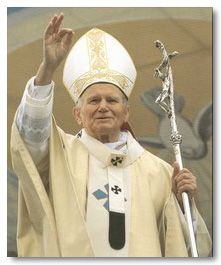A providential gift
- FATHER RAYMOND J. DE SOUZA
Amongst the thousands of cobblestones in St. Peters Square, there is one that is painted red.
 |
It is not far from the great Bronze Doors that open on to Bernini’s epic Scala Regia, the grand stairway that, in the days of horse-drawn carriages, would conduct kings to the threshold of the Sistine Chapel, or to the various rooms of the Apostolic Palace. It was down the Scala Regia that, just over a year ago, the mortal remains of Pope John Paul II were carried, through the Bronze Door, past the red cobblestone, and into the Square for the final time.
The blood-red cobblestone marks the spot where he was shot, 25 years ago today. Had things been otherwise, John Paul’s funeral Mass would have been held in 1981, and history would have remembered a pontificate, full of promise, cut short. He survived of course, and for nearly 27 years kept his promises to those he exhorted to be not afraid, and history became less fearful.
“One hand fired the shot, another guided the bullet,” he would later say of his surviving the assassination attempt. Mehmet Ali Agca, a professional assassin who shot him from point-blank range, would later tell John Paul of his astonishment that he survived. Indeed, the bullet that ripped through the Pope’s abdomen took a most providential path, missing the major arteries and nerves that would have lead to instant death or permanent paralysis. In his final testament, John Paul would write that “divine mercy” had intervened to save his life, that he might serve the purposes of Providence in history. He would die, 24 years later, on the very Feast of Divine Mercy, which he had instituted for the Church.
The events of May 13, the liturgical feast of Our Lady of Fatima, were experienced by John Paul as particular manifestation of divine providence. It was the Marian apparitions at Fatima in 1917 that prophesied an age of martyrdom, including attacks on the pope himself. John Paul believed that the prophecies were fulfilled in a particular way on May 13, 1981, and that his life was spared by Mary’s intercession. A year after the shots were fired, he went to Fatima himself, where he sent the bullet that tore through his body. It is now part of the crown of the Marian statue at the shrine.
The red cobblestone, amid the size and splendour of the Vatican City, is rather hard to find, and, in the end, just that, a red cobblestone. But it marks for the thousands who come here, a discreet reminder of the finger of God in history, and the life of the man they come not to mourn, but to visit. |
John Paul always had the sense that his life — from the early days in the clandestine seminary in Nazi-occupied Poland, to the insistence of the spectacularly-miscalculating communist authorities that he be made Archbishop of Krakow — was directed in an almost tangible way by divine providence. That intuition is now tangibly evident in Rome.
The very first public words of Pope Benedict XVI were: “After the great Pope John Paul…”. He refers to him most often now as “the great John Paul,” intimating that once declared a saint, he will be given the official title, rare in the Church’s history, of John Paul the Great.
The priest in charge of overseeing the process for the late Pope’s canonization, Father Slawomir Oder, told me that he can’t keep up with the flood of letters, testimonies and accounts of favours and miracles from all over the world. But one needn’t take Father Oder’s word for it. The devotion of the people is evident daily at St. Peter’s.
The extraordinary crowds that came last year to pay homage to John Paul when he was lying in state have simply not stopped. The authorities at St. Peter’s have had to completely re-route the traffic flow into the church, designating a special queue for his tomb. That queue often stretches around the Square, and has not stopped since April 2005. There are an average of 15,000 people a day at his tomb; more than 1,000/hour, in excess of five million pilgrims to date. It is extraordinarily moving to see them come, young and old, many pious and prayerful, others curious, in an unending wave of humanity.
They have concluded that this man’s life was a providential gift. Last year, during the funeral, they shouted “santo subito” — sainthood now! The Church will decide about that, sooner rather than later, but for now it is enough to watch them come, hour after hour, confident that while all proceeds under the guide of Providence, in this spot it is particularly manifest.
The red cobblestone, amid the size and splendour of the Vatican City, is rather hard to find, and, in the end, just that, a red cobblestone. But it marks for the thousands who come here, a discreet reminder of the finger of God in history, and the life of the man they come not to mourn, but to visit.
 This is Meaghen Gonzalez, Editor of CERC. I hope you appreciated this piece. We curate these articles especially for believers like you.
This is Meaghen Gonzalez, Editor of CERC. I hope you appreciated this piece. We curate these articles especially for believers like you.
Please show your appreciation by making a $3 donation. CERC is entirely reader supported.

Acknowledgement
Father Raymond J. de Souza, "A providential gift." National Post, (Canada) May 10, 2006.
Reprinted with permission of the National Post and Fr. de Souza.
The Author
Father Raymond J. de Souza is the founding editor of Convivium magazine.
Copyright © National Post

